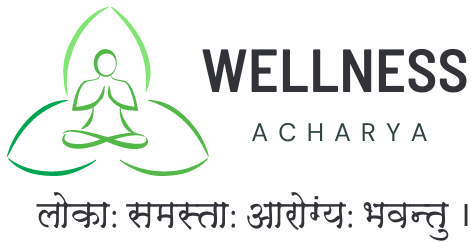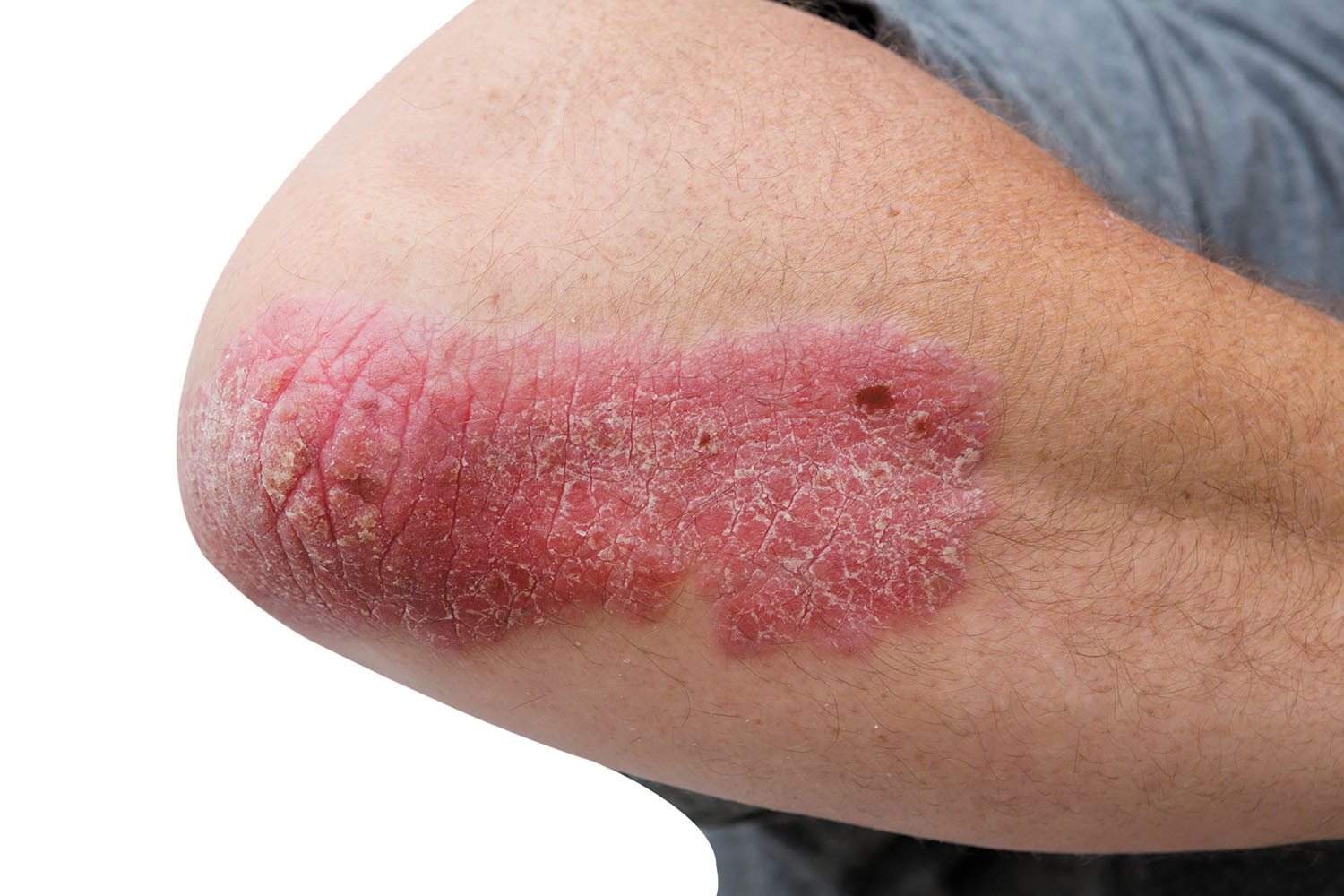AYURVEDA FOR PSORIASIS
According to ayurveda, kushta roga (skin disorders) that correlates to psoriasis is triggered by imbalances in kapha (the bodily humor associated with the elements of earth and water) and vata (the bodily humor associated with the elements of air and ether) doshas.
Vitiated kapha causes your skin to become coppery or whitish in color while vitiated vata causes it to become scaly and dry. A disturbance in vata can also lead to abnormally quick proliferation of cells in the skin while vitiated kapha can lead to itching. Additionally, the build-up of ama or metabolic waste, genetic factors, environmental stressors, and unhealthy dietary and lifestyle habits contribute to psoriasis.
1. Nidana Parivarjana: Avoiding Factors That Cause Psoriasis
Unhealthy habits, both diet and lifestyle based, act as triggers for psoriasis and tackling these is an important part of ayurvedic treatment. Here are some broad steps that will be put in place:
- Improper dietary habits are considered to be a significant cause of psoriasis in ayurveda. Having excessive amounts of certain foods such as citrus fruits, curd, fish, horse gram, sweets, sesame oil, black gram, rice flour, milk, and jaggery should be avoided. In general, excessively salty, spicy, or sour foods, carb-heavy, refined, or sugar-laden foods, as well as foods that are heavy and difficult to digest, are discouraged.
- Ayurveda also cautions against having foods that are incompatible with each other (virrudha ahara) at the same time as this may have a toxic effect. An example of incompatible foods would be fish and milk.
- Sleeping during the day, suppressing the natural urges of your body, and excessive exposure to the sun or heat are also to be avoided.
- Ayurveda also recommends controlling emotions such as excessive anger, worry, or grief which can all act as triggers. This can be done through mindful meditation and practice of yoga.
2. Panchakarma Chikitsa: Purifying Treatments That Purge Toxins
Cleansing and purifying treatments such as vamana (therapeutically induced vomiting), virechana (therapeutic purgation using herbs), basti (therapeutic enema) are considered to be vital in the treatment of psoriasis. Based on your individual constitution, your ayurvedic doctor will decide which procedure or combination of procedures will work best for you. Before carrying out a panchakarma treatment, preparatory procedures known as purvakarma are carried out to make the treatment effective. A typical treatment might involve:
Snehana and svedana: Before panchakarma therapy, preparatory procedures like snehana and svedana are carried out so that toxins located in different parts of the body may be brought into the alimentary canal, from where they can be removed through panchakarma. Snehana or oleation involves lubricating the body externally or internally so that toxins are softened and channeled into the alimentary canal. Ghee or other oils may be administered internally in increasing doses over a few days for this. A body massage with an appropriate herbal oil such as bala oil, bakuchi oil, dashmoola oil etc. can also form part of snehana.
Meanwhile, during svedana or sudation, heat is applied to the body for channeling toxins into the alimentary canal. Also known as sweating therapy, svedana may involve practices such as fomentation using steam (sarvanga bashpa sveda) or a hot bath with medicinal herbal decoctions (avaghaha sweda).
Vamana: Although other panchakarma treatments might also be used for dealing with psoriasis, vamana is usually an invariable part of treatment and typically done before other treatments like virechana and basti. Scientific research also confirms the effectiveness of this therapy. One study found that when vamana therapy was administered to patients, it effectively reduced symptoms of psoriasis such as scaling, erythema, burning sensation, itching, and dryness of skin in subjects. Madanaphala (Randia dumetorum), yastimadhu (Glycyrrhiza glabra), and vacha (Acorus calamus) were used to induce vomiting. Preparatory swedana and snehana were done for 9 days before the procedure.
Once vamana is completed, virechana or basti may be taken up on a case to case basis.
3. Shamana: Treatments To Pacify Vitiated Doshas
Shamana therapies are meant to pacify and recalibrate vitiated doshas. They may be administered independently or after panchakarma therapies and can involve taking herbs, nourishing foods, and unctuous substances. External treatments may involve applying herbal pastes, massages with oil, and bathing in medicinal liquids. Some examples include:
Herbal formulations, to be taken with ghee or honey, may include trikatu, triphala, dashamoola, raktapachakvati, gandhak rasayan, suvarna makshik bhasm, swayambhu guggulu, rasamanikya, and mahatiktak ghruta. The exact prescriptions and dosages will be decided depending on how you’ve responded to treatment so far.
Nourishing remedies such as:
- Buttermilk, to helps correct imbalances in vata and kapha. It can be taken orally as well as used locally to treat psoriasis. Interestingly, buttermilk is rich in lactic acid which has been found to moisten skin and reduce psoriatic scales on topical application.
- A sandalwood decoction, made by brewing a teaspoon of sandalwood in three cups of water until it reduces to a cup. This is then to be taken thrice a day with a few drops of rose water and some sugar to sweeten.
- Cabbage juice, half a cup of which is to be had every day. This helps with healing and recovery.
Topical remedies include diluted lime juice, aloe gel, or a paste of powdered and boiled almonds. Covering the affected area with a fresh banana leaf is thought to help fight the inflammation. A paste of shikakai (soap pod) can also be applied topically to soothe and heal the skin. Other herbal remedies like musta (Cyperus rotundus) and manjistha (Rubia cordifolia) may also be prescribed for topical application.
Shirodhara, a practice where beneficial liquids are poured on your forehead in a gentle stream, is used to alleviate stress and mental disturbances. Stress often aggravates or even triggers psoriasis. This therapeutic practice can stimulate vital areas on your body known as marmas, helping improve your circulation and the functioning of the autonomic nervous system which was disturbed due to stress. Takradhara using buttermilk is especially considered beneficial.
Brief, but regular exposure to sunlight (atapa seva) is thought to help clear psoriasis. But this is carefully regulated so the skin is never overexposed to the sun. Sunburns, like other injuries to the skin, can trigger psoriasis.
While these provide a broad outline of the kind of remedial treatments used to control and counter psoriasis, an ayurvedic practitioner will always customize the therapy to suit your individual case. Self-medicating with herbal remedies is not advisable if you have psoriasis, especially if you are on allopathic medicines as well. Always seek out an experienced ayurvedic doctor and keep them posted about any other medications you are on.
Ayurvedic treatment for psoriasis is essentially a sustained, holistic regimen that you need to undertake at a steady pace. It may stretch between 3–6 months, with regular follow-ups after that to avoid flare-ups and relapses. But as many case studies have shown, these therapeutic interventions and lifestyle changes can help you tackle psoriasis head on and make a huge difference to your quality of life.

